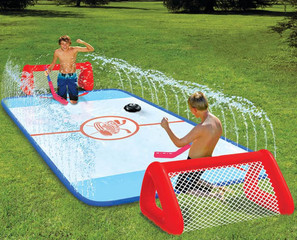There’s just a couple of weeks left in summer and as head coach of the Devil’s team I’m in the process of finalizing the September hockey schedule. As usual, the most apt adjective I can use to describe said schedule is jam-packed. What I have so far includes 7 practices, 3 development ice times, 4 dryland training sessions, 3 exhibition games, a minimum 3-game and hopefully 5-game tournament to kick off the season and the all-important team picture night. For those keeping score, that’s at least 20 ice/training times over a 30 day period. I’ve been asked by rival coaches and have opportunities to add in a couple of other games, but want to be careful not to over do it with the hustle and bustle of kids heading back to school added into the mix. Outside of her schedule we also have the Boy leaving the roost for university, which will likely require a planned visit to be lodged in somewhere and I, selfishly have a 19th annual boy’s weekend on the docket. Oh yeah, I do have a full time job as well to occupy what’s left of my semi-conscious time. So as I write here I am feverishly searching for a reputable cloning machine manufacturer. Any recommendations are welcomed. With one no longer playing minor hockey you’d think the grind would ease and I suppose it actually has, but it sure doesn’t seem like it.
Likewise typical for me, and others I’m sure, is pre-season hockey drama. Neither skates nor sticks have touched the ice and my team has already lost one of its top defenders for the entirety of next season. I was advised by her father a couple of weeks ago she was offered a scholarship to go to school and play hockey at a nearby private hockey school. An opportunity I certainly cannot begrudge this young athlete, however, one which puts our team in something of a bind. Our choices are to try to fill the spot with another player from a lower level team or try to proceed with only five defenders. The problem with option one is the team directly below us is likewise missing a player in addition to the coach of that team not being my biggest fan. He may share, but methinks he certainly wouldn’t be happy about it. The second option is likewise not preferred as midget-aged girls’ teams tend to run into either suspension or injury-related issues as a season unfolds. And so, we are in semi-scramble mode looking for a way to make our handicapped team whole.
Otherwise, I feel very positive about our team’s prospects for the upcoming season, as well I should, based on its current construction. We’ve been running optional dry land training sessions since the middle of June, which have been relatively well attended, particularly the last few as summer schedules have wound down for many players and their families. You get the sense many are raring to get back on the ice. The interactions I’ve noted between the players who’ve attended have been very good; a key consideration when creating a “team” and a positive environment; core messaging delivered a couple of weeks ago at a coach’s refresher clinic I attended. Hockey Canada, quite rightly I believe, is actively endorsing the notion of a Long Term Development Model, which includes making sure having fun is a central theme in an effort to stem the tide of dropping registration; albeit more so in boys’ than girls’ hockey. One of my primary coaching philosophies has always been to promote a positive atmosphere and to hopefully cultivate a group of players who want to keep playing the game well beyond their minor hockey years. Winning, of course, generally makes creating such an atmosphere a much easier proposition, however, a successful season cannot simply be measured in stats. I feel like this season’s team has a good base for success and now it will be up to me and my coaching staff to build upon it. It’s time to set the wheels in motion, build up speed, try to avoid the occasional pot holes and hopefully cross the finish line ahead of the pack in one piece.
#imahockeydad



